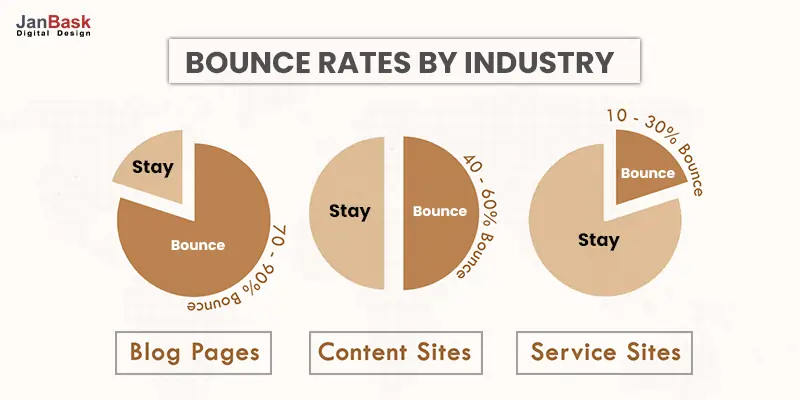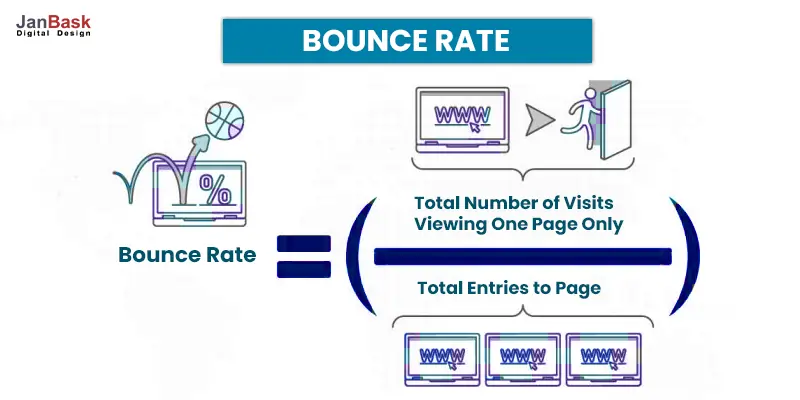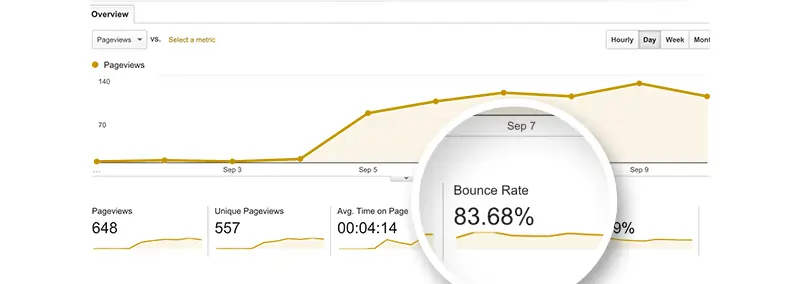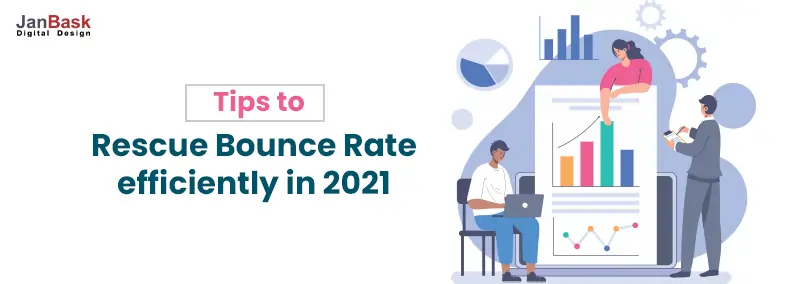
Owing or designing a website for your business is not a new thing! Even if you don’t have any market or technical knowledge, you may have certainly gone through the term “Bounce Rate” and must have understood enough that having a high bounce rate is not good for your business. Simultaneously having a low bounce rate of visitors on your website is a good sign.

Here, we are going to help you get in-depth knowledge and understanding of Bounce rate Analytics: What is the “bounce rate” in google analytics? How is it calculated? What is a good bounce rate for a website? How to reduce the bounce rate on your website? And much more!
To start with, let’s get familiar with “What is Bounce Rate Analytics?” According to Google Analytics, “A bounce refers to a single-page session done by a visitor on your site.” Moreover, Neil Patel who is one of the New York Times best-selling authors says, “A website’s bounce rate is the percentage of all visitors who enter and exit your website's same page, without performing any action or clicks to other pages on your website.”
Moreover, there are certain reasons that your visitors can bounce from your website such as:
In case, you have various site visitors landing and promptly leaving your page without performing any conversion action then the reason may be that your web pages aren't performing well. But to get to any conclusion, you need to get into addressing the exact error at your website via Bounce rate Analytics.
Why Are Visitors Bouncing Off Your Site?
In case, your conversion rate is low and your bounce rate is off the charts, your website may have major conversion rate optimization (CRO) problems. However, there are some common reasons your bounce rate isn’t looking as healthy as it should comprise:
Hire professionals here, to help you manage your Bounce Rate Analytics efficiently!
We hope you have got a good “understanding of Bounce rate analytics”, “How to find and analyze it for your business?”. Further, you may get confused in making sense of the numbers displaying your bounce rate in Google Analytics. And to make you understand this, we are here to help you!

It doesn’t matter whether you are new to analytics or have used it before. You have probably been friendly with your analytics dashboard, going incessantly upwards or lower. Well, going low is fine but it can strike your nerves if your analytics dashboard is going upwards instantly.
There are various tools or platforms that can help you understand your analytics easily including SEMrush. With SEMrush, the bounce rate google analytics serves you with the fourth-most-necessary ranking factor on Search engine outcome pages (SERPs), however, it's nerve shocking to see why the number is worth paying attention to.
So, what is considered to be a good bounce rate?
There are multiple answers given by the experts, but in general, a healthy or good bounce rate lies between 41-51%, and a bad bounce rate is considered to be around 70+ percent zone.
To get the most insights from your Google Analytics bounce rate, you will have to enable benchmarking at your website, to get a visualization of the average bounce rate in your industry. As with benchmarking, you can even view section-specific bounce rates and get a better idea of where within the range your website should fall.
Moreover, the first initials you grip on will likely be in the Audience Overview report, which offers the overall bounce rate of your website so that you can make better decisions. But when you are securely driving in google analytics alone or via professional help, you should also examine your number from various perspectives.
To get the numbers you can click on the All pages report at Google analytics, which gives you the bounce rate for individual pages, and the channels report shows you the percentage for each channel grouping efficiently.
However, Remember, having a lower Google bounce rate means you have a better chance of converting visitors into customers, and having a higher bounce rate means your website isn’t doing well in engaging visitors and Hence you are losing out on valuable leads.
If we go according to the analytics rule, the bounce rate above 70-80% is quite horrible, between 50-70 % bounce rate is considerable or average, 30-50% can be considered to be a good bounce rate for your website.

And when your bounce rate comes out to be as low as 20% or lower than this. Then it could be due to some tracking error in such cases, you should try some other tools or look for plugins, etc. so that you can get some reliable outcomes for your website.
These values however are dependent on certain factors as we can not always go by this rule. Being professionals, we don't recommend you to make it your thumb rule as it totally depends on the type of industry you are in.
Read: How to Reduce Bounce Rate?
Now that you have a better understanding of the google analytic metric, what it’s telling you, and why your numbers look the way they do, the question of how to lower bounce rate is easy, that is you need to work on your website. If it seems like you need to diminish bounce rate across your entire website, one of the reasons could be your content that's a significant indicator of how your content isn’t engaging your visitors.

But there could be other reason, here are some immediate steps that you can take towards an improved bounce rate and for a better performing website:
Take a Look at Your Top Exit Pages
In Google Analytics, locate the report for your Exit Pages. You can lower your website bounce rate by comparing the bounce rate and exit rate on your top traffic pages. This helps you analyze how many visitors are landing directly on your page, how many are landing through internal linking and which pages are most frequently being abandoned, helping you slow down the pages where improvements need to be made.
Improve Your Content and Readability
It seems almost too obvious, but it’s one of the best things you can do to diminish bounce rate and enhance your website’s conversions rate. Make sure your visitors aren’t turned away by something like too much text and a bad layout. Ask yourself:
It is also a good time to look at the choice of your font style and size and the amount of white space on your page. Even the simplest and smallest change could be an answer to your question: How to lower bounce rate?
Use Images and Videos
Having a high bounce rate is a good indication of a website that isn’t engaging. Preventing a poorly performing page that isn’t retaining a visitor’s attention can be done with the most attention-grabbing form of media like videos, gifs or other infographics. Using such visual elements get your audience engaged with your content and keep them hanging around for a little while longer.
Consider the Placement of Your CTAs
A solution to reduce bounce rate could be as small as a Call to action. Look at your call-to-action buttons with a critical eye, specifically their location on the page, the copy, color and size. Using attractive CTAs with copy that is compelling or offers FREE trials can do wonders for conversion. Sometimes, the simplest fix on your website is also most effective for better outcomes.
Improve Your Site’s Speed
In a matter of seconds, your visitors make up their mind about your website. The decision is based on various factors, but one of the most important is site speed. The main reason behind the high bounce rate could be your website's slow loading time. Google Analytics allows you to access your Page Timings report to analyze each page individually as well as the overall average speed of your site. Initiate working on the webpages that have higher traffic and slower load times to make the most of your efforts worth it.
What are the myths about Bounce Rate Analytics?
Remember, Google bounce rate is the most tricky thing to get to grips with is that a high bounce rate does not instantly signify a terrible website. For one, the average bounce rate will differ across industries i.e. B2B, B2C, and much more. If you own an eCommerce site with a blog component then your blog post would likely have a very different bounce rate percentage. It will also help you drag down the comparatively good numbers your product pages might be pulling.
Other than this, you should also remember and focus on the “How”, “What” and “Why” of the specific number of your bounce rate. This could look like a number of interactions you need to keep in mind such as:
Even though in all such cases, the visitor is clearly engaged and the session is a big hit. Remember, the answer for “What is a good bounce rate?” will differ depending on your website and industry type.
In case you are not a webmaster or analytics expert, the challenge lies in regulating a reasonable bounce rate for your specific business site. In such cases, Google Analytics service provider, who can access Google bounce rate in connection with other relevant metrics such as the total time spent on page and the average session duration a visitor has visited.
While its crystal clear why bounce rate can’t be analyzed at the surface level, the fact is:
your website can have an exceptionally high bounce rate and a low conversion rate, regardless of your industry type.
No, bounce rate google analytics is not a necessary factor for better Google ranking as it is just a metric! There are 199 other factors that together affect or trigger the Google ranking. However, other than just for Google ranking, maintaining a positive bounce rate is good to keep up with the customers, business, and competitors.
The key takeaway from this article is that maybe the bounce rate doesn’t directly affect your page ranking, but there are still few things that you should understand and try to improve upon for better outcomes.
High bounce rates (when calculated specifically) are often symptoms of serious website problems such as user experience issues or poor targeting. These are the things that being a business person, you should worry about. If you work on these deeper problems such as usability and customer targeting, Bounce rate analytics, your website’s SEO problems tend to improve as well which will simultaneously serve you with positive results.
Avail our professional conversion rate optimization services to reduce your bounce rate and maintain your web for top ranking in SERP.
Share your thoughts on Bounce rate Analytics with us, we would be happy to hear them!
A
I was aware of the term Bounce Rate Analytics, but didn’t know about how to measure, assess, and audit bounce rates to enhance conversion rate. All thanks to your blog information.
J
“Hello, JanBask Digital Design offers multiple web design and development services to nurture your skills and make you ready for an amazing career run. Please write to us in detail at info@janbaskdigitaldesign.com. Thanks!
R
Hi! The blog is really helpful. I was seeking information related to Bounce rate Analytics and then I found your blog. It includes all the relevant information that I require! Thanks team..
J
Hi, Thank you for reaching out to us with your query. Drop us your email id here and we will get back to you shortly!
P
I would definitely recommend this article to anyone who wants to understand Bounce rate analytics can go through this article thoroughly.
J
Glad you found this useful! For more such insights on your favorite topics, do check out JanBask Digital Design Blogs and keep learning with us!
R
I have used these listed points to reduce bounce rate and they were really helpful. I would highly recommend you to use these tactics.
J
Thank you so much for your comment, we appreciate your time. Keep coming back for more such informative insights. Cheers 🙂
J
This blog is overall informative and helpful, I really wanna thanks to the JanBask team. Thanks a lot, team!
J
Hi, Thank you for reaching out to us with your query. Drop us your email id here and we will get back to you shortly!
C
Nice blog really helped me in understanding the bounce rate and how it affects organic ranking.
J
Glad you found this useful! For more such insights on your favourite topics, do check out JanBask Blogs and keep learning with us!
T
Listed good points to reduce bounce rate, i will try to apply all these practices to improve it.
J
Glad you found this useful! For more such insights on your favourite topics, do check out JanBask Digital Design Blogs and keep learning with us!
S
My website bounce rate is going very high, i need to outsource SEO support to improve that, can you help me with that.
J
Hi, Thank you for reaching out to us with your query. Drop us your email id here and we will get back to you shortly!
D
I was also struggling with the same listed myths, but thanks to this blog now I know the real facts.
J
Thank you so much for your comment, we appreciate your time. Keep coming back for more such informative insights. Cheers 🙂
C
Presently my site bounce rate is going 90%, i know it is too bad and after reading this blog i know all possible practices to improve that.
J
Thank you so much for your comment, we appreciate your time. Keep coming back for more such informative insights. Cheers 🙂